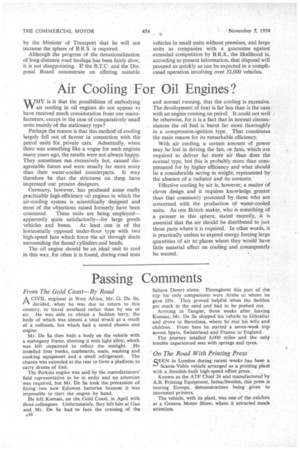Vital Drops in the Ocean
Page 31

Page 32

If you've noticed an error in this article please click here to report it so we can fix it.
THE. demand for small Success of transport units continues. Turns Largely . Supporting . evidence is supplied by the results of list 7, .Small Buyers published last week, and is recognized by the British Transport Commission and the Road Haulage Disposal Board, 'who have again catered, for the mall man in list 8,, which " was issued on Wednesday.
More vehicles are being sold in units including premises, but the number is still insufficient to justify a .policy -of offering "property'" lots except to meet known" demands. There is little interest in large fleets of vehicles .put up for sale in units for public tender, but they may be More easily disposed of in companies by the sale of shares. -•ListS. 6 and 7 were both large and were designed specifically for small men. _ In each case the average number of vehicles per unit was about three. The • sale of 50 per cent, of the vehicles in list 6 was : regarded as reasonable, but the results of list 7 are even better, for 58, per cent. of the vehicles have found buyers. The proportion of lorries sold without premises has fallen from 71 per cent, in list 6 to 67 per cent. in list 7, but in the" property "class, the percentage of vehicles disposed of has risen from 3:to 13.
Bids for Alf Vehicle Units It is significant that bids Were made for all the vehicles offered without premises in list 7, whereas in the case of list 6, 5 per cent. of the assets put up for sale in this form attracted no tenders. On the other hand, no bids were made for 35 per cent. of the vehicles accompanied by penises in list 7, compared With only /6 per cent. in list 6.
It is difficult to reconcile with the greater volume of sales the increase in the incidence of "no bids" for Vehicles allied to property, but the implication is that when a unit is attractive to a buyer, he is now more willing to offer a price acceptable. to the B.T.C. and the Disposal Board. If he is not seriously interested,: he is more inclined -to_ leave it severely alone.
A different picture is presented by the two special lists, for whith results were also published last week. Both: were designed for large,.buyers. Denationalization and some of the units in each on 'Readiness 'of were assembled to meet known requirements. The average to Take Up. Units number of. vehicles per unit in list SJ was 25 and in list S.2 , 50. List S.1 consisted entirely of units with premises; whereas. list S.2 included a few Vehicle-only lots.
In list S.1, only 23 per cent of the vehicles offered were sold. For list S.2, the result—with decisions concerning 45 vehiClei deferred—was even worse at 20 per cent.. The percentages of cases in which all" tenders were rejected. were respectively 47 and 52. , The'results of list S.2 were preindiced by: the failure to sell British Road Services' meat section, which accounted for 574 of the 591 vehicles that did not find buyers. An encouraging sign is, however, provided by the reduction in the proportion of "no bids" for vehicles from 30 per cent. in the case of list S.1 to 23 per cent. in list S.2.
"Top Weight " for Units The evidence of the two special lists suggests that something in the region of 20 is the maximum size of a fleet for which a ready sale can be found by way of a unit. In the case of list Si, excluding the Thatcham depot of B.R.S., which included 85 licensed vehicles, the average number of vehicles per unit sold was 16. In list S.2 the comparable figure was 20, against an overall average of 50.
One of the impediments to the sale of large units is a fear among prospective buyers that the Govemment may be compelled to amend the Transport Act, 1953, to allow, the Commission to take.an -interest, either controlling or 'otherwise, in the companies loftedfor sale other than as transport units. Some senior members of the staff of B.R.S. belieVe that this will happen.
They have the Opportunity and the capital to reacquire substantially the Undertakings .Which were taken over from them under the1947 Actbut they. are not doing so because they fear that they would not be able to Withstand the Competition of B.R.S. if the Commission's holding in road haulage were' allowed to be extended. If c'enfidence is to ),:he instilled into. potentialbig buyers, an assurance by the Minister of Transport that he will not increase the sphere of B.R.S. is required.
Although the progress of the denationalization of long-distance road haulage has been fairly slow, it is not disappointing. If the B.T.C. and the Disposal Board concentrate on offering suitable vehicles in small units without premises, and large units as companies with a guarantee against extended competition by B.R.S., the likelihood is, according to present information, that disposal will proceed as quickly as can be expected in a complicated operation involving over 32,000 vehicles.




















































































































